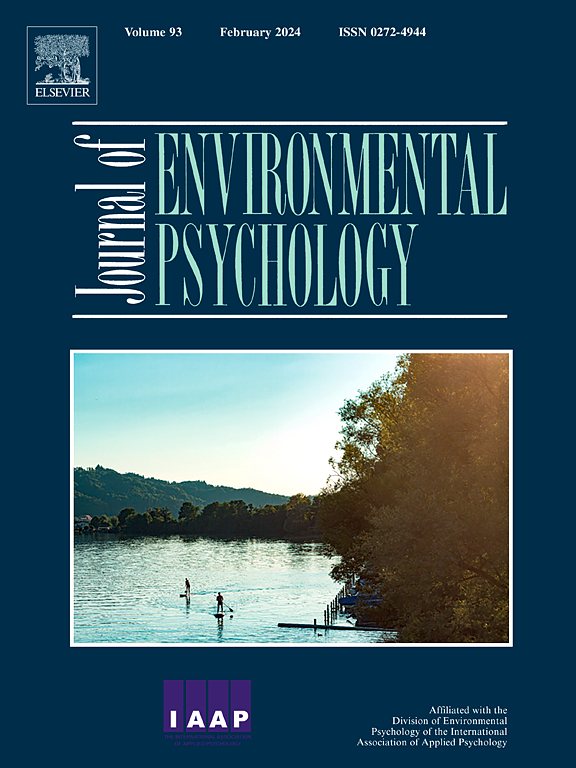出行体验性别差异的空间-情感决定因素:人-环境不适应和犯罪恐惧对通勤者情感体验和逃避出行环境行为意愿的影响
IF 7
1区 心理学
Q1 ENVIRONMENTAL STUDIES
引用次数: 0
摘要
本研究考察了巴黎火车网络中环境感知、影响和随后的行为意图方面的性别差异。从性别研究和环境心理学的角度,我们调查了解释性别流动性差异的心理因素。我们引入了一种新的方法,将人-环境(PE)不适合作为一个人的情感内涵与其环境之间的代数差异,并通过评估犯罪恐惧的影响。根据空间男性中心主义的文献,我们假设更强的女性性别认同会预测更消极的PE不适应和更大的犯罪恐惧,这反过来会引发负面影响并增加回避该场所的意图。我们在两项预先登记的研究(总N = 2637)中测试了这个模型:一项是对巴黎火车站台上的通勤者进行的实地研究(N = 1555),另一项是对有代表性的法国样本(N = 1082)进行的在线研究,这些样本对车站的照片有反应。结果证实,体育不适应、犯罪恐惧和情感状态在女性性别认同与逃避环境行为倾向之间起中介作用。这些发现为创造更具包容性的公共空间提供了一个新的框架,表明针对改善人与环境契合度的客观环境和降低犯罪恐惧的感知安全的干预措施对于促进公平的流动性和所有人的空间福祉至关重要。本文章由计算机程序翻译,如有差异,请以英文原文为准。
The spatio-affective determinants of gender discrepancy in mobility experience: Influence of person-environment misfit and fear of crime on commuters' affective experience and behavioral intention to avoid mobility environments
The present research examines gender disparities in environmental perception, affect, and subsequent behavioral intentions within the Parisian train network. Drawing from gender studies and environmental psychology, we investigated psychological factors explaining mobility differences across genders. We introduce a novel approach by operationalizing person-environment (PE) misfit as the algebraic difference between the affective connotations of a person and their environment, and by assessing the influence of fear of crime. In line with spatial androcentrism literature, we hypothesized that stronger feminine gender identification would predict a more negative PE misfit and greater fear of crime, which in turn would elicit negative affect and increase intentions to avoid the place. We tested this model in two preregistered studies (total N = 2637): a field study with commuters on Parisian train platforms (N = 1555) and an online study using a representative French sample (N = 1082) who reacted to photographs of a station. Results confirmed that PE misfit, fear of crime, and affective state mediated the relationship between feminine gender identification and the behavioral tendency to avoid the environment. These findings offer a new framework for creating more inclusive public spaces, demonstrating that interventions targeting both the objective environment to improve person-environment fit and perceived safety to lower fear of crime are essential for fostering equitable mobility and spatial well-being for all.
求助全文
通过发布文献求助,成功后即可免费获取论文全文。
去求助
来源期刊

Journal of Environmental Psychology
Multiple-
CiteScore
10.60
自引率
8.70%
发文量
140
审稿时长
62 days
期刊介绍:
The Journal of Environmental Psychology is the premier journal in the field, serving individuals in a wide range of disciplines who have an interest in the scientific study of the transactions and interrelationships between people and their surroundings (including built, social, natural and virtual environments, the use and abuse of nature and natural resources, and sustainability-related behavior). The journal publishes internationally contributed empirical studies and reviews of research on these topics that advance new insights. As an important forum for the field, the journal publishes some of the most influential papers in the discipline that reflect the scientific development of environmental psychology. Contributions on theoretical, methodological, and practical aspects of all human-environment interactions are welcome, along with innovative or interdisciplinary approaches that have a psychological emphasis. Research areas include: •Psychological and behavioral aspects of people and nature •Cognitive mapping, spatial cognition and wayfinding •Ecological consequences of human actions •Theories of place, place attachment, and place identity •Environmental risks and hazards: perception, behavior, and management •Perception and evaluation of buildings and natural landscapes •Effects of physical and natural settings on human cognition and health •Theories of proenvironmental behavior, norms, attitudes, and personality •Psychology of sustainability and climate change •Psychological aspects of resource management and crises •Social use of space: crowding, privacy, territoriality, personal space •Design of, and experiences related to, the physical aspects of workplaces, schools, residences, public buildings and public space
 求助内容:
求助内容: 应助结果提醒方式:
应助结果提醒方式:


